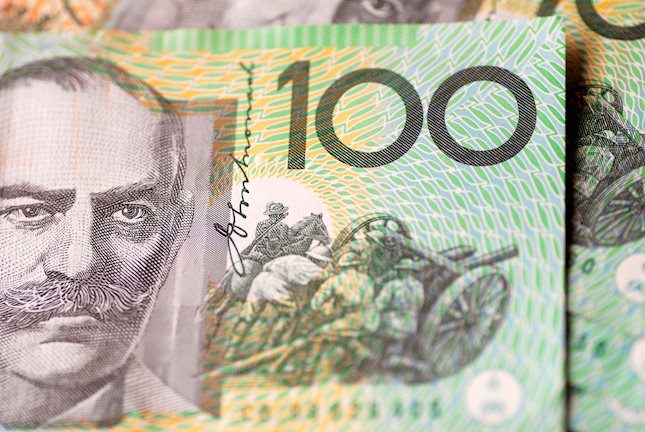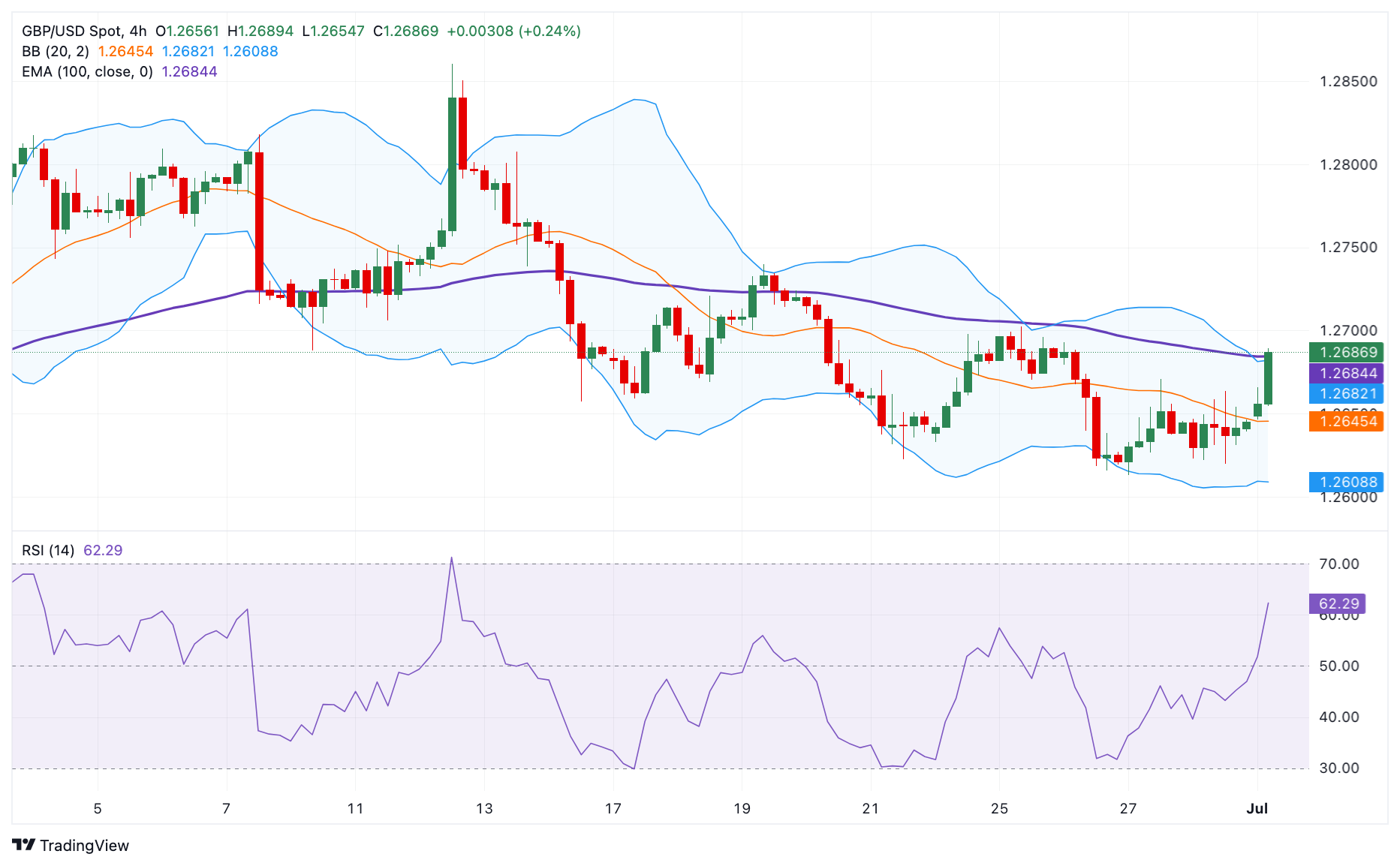- GBP/USD trades on a stronger note near 1.2680 in Monday’s early European session.
- The pair maintains the negative stance on the 4-hour chart, with the bearish RSI indicator.
- The key resistance level will emerge in the 1.2680-1.2685 region; the initial support level is located at 1.2610.
The GBP/USD pair attracts some buyers around 1.2680 during the early European session on Monday. The decline of the Greenback after softer US Personal Consumption Expenditures (PCE) Price Index data creates a tailwind for the major pair. Investors will keep an eye on the US ISM Manufacturing PMI for June on Monday. The general election in the United Kingdom is scheduled for Thursday.
According to the 4-hour chart, the bearish outlook of GBP/USD remains intact as it holds below the key 100-period Exponential Moving Average (EMA). However, the Relative Strength Index (RSI) crosses above the 50-midline, indicating that further upside looks favorable.
The key resistance level for GBP/USD will emerge in the 1.2680-1.2685 zone, portraying the confluence of the upper boundary of the Bollinger Band and the 100-period EMA. A decisive break above this level will see a rally to 1.2700, the psychological level and a high of June 25. Further north, the next hurdle is seen at 1.2740, a high of June 19.
On the flip side, the initial support level for the major pair is located at 1.2610, the lower limit of the Bollinger Band. The additional downside filter to watch is 1.2583, a low of May 15. The next contention level is seen at 1.2502, a low of May 10.
GBP/USD 4-hour chart
Pound Sterling FAQs
The Pound Sterling (GBP) is the oldest currency in the world (886 AD) and the official currency of the United Kingdom. It is the fourth most traded unit for foreign exchange (FX) in the world, accounting for 12% of all transactions, averaging $630 billion a day, according to 2022 data. Its key trading pairs are GBP/USD, aka ‘Cable’, which accounts for 11% of FX, GBP/JPY, or the ‘Dragon’ as it is known by traders (3%), and EUR/GBP (2%). The Pound Sterling is issued by the Bank of England (BoE).
The single most important factor influencing the value of the Pound Sterling is monetary policy decided by the Bank of England. The BoE bases its decisions on whether it has achieved its primary goal of “price stability” – a steady inflation rate of around 2%. Its primary tool for achieving this is the adjustment of interest rates. When inflation is too high, the BoE will try to rein it in by raising interest rates, making it more expensive for people and businesses to access credit. This is generally positive for GBP, as higher interest rates make the UK a more attractive place for global investors to park their money. When inflation falls too low it is a sign economic growth is slowing. In this scenario, the BoE will consider lowering interest rates to cheapen credit so businesses will borrow more to invest in growth-generating projects.
Data releases gauge the health of the economy and can impact the value of the Pound Sterling. Indicators such as GDP, Manufacturing and Services PMIs, and employment can all influence the direction of the GBP. A strong economy is good for Sterling. Not only does it attract more foreign investment but it may encourage the BoE to put up interest rates, which will directly strengthen GBP. Otherwise, if economic data is weak, the Pound Sterling is likely to fall.
Another significant data release for the Pound Sterling is the Trade Balance. This indicator measures the difference between what a country earns from its exports and what it spends on imports over a given period. If a country produces highly sought-after exports, its currency will benefit purely from the extra demand created from foreign buyers seeking to purchase these goods. Therefore, a positive net Trade Balance strengthens a currency and vice versa for a negative balance.
Information on these pages contains forward-looking statements that involve risks and uncertainties. Markets and instruments profiled on this page are for informational purposes only and should not in any way come across as a recommendation to buy or sell in these assets. You should do your own thorough research before making any investment decisions. FXStreet does not in any way guarantee that this information is free from mistakes, errors, or material misstatements. It also does not guarantee that this information is of a timely nature. Investing in Open Markets involves a great deal of risk, including the loss of all or a portion of your investment, as well as emotional distress. All risks, losses and costs associated with investing, including total loss of principal, are your responsibility. The views and opinions expressed in this article are those of the authors and do not necessarily reflect the official policy or position of FXStreet nor its advertisers. The author will not be held responsible for information that is found at the end of links posted on this page.
If not otherwise explicitly mentioned in the body of the article, at the time of writing, the author has no position in any stock mentioned in this article and no business relationship with any company mentioned. The author has not received compensation for writing this article, other than from FXStreet.
FXStreet and the author do not provide personalized recommendations. The author makes no representations as to the accuracy, completeness, or suitability of this information. FXStreet and the author will not be liable for any errors, omissions or any losses, injuries or damages arising from this information and its display or use. Errors and omissions excepted.
The author and FXStreet are not registered investment advisors and nothing in this article is intended to be investment advice.
Recommended content
Editors’ Picks

AUD/USD side-lines near 0.6200 as traders await US NFP report
AUD/USD consolidates near 0.6200 early Friday, just above its lowest level since October 2022 as traders move to the sidelines ahead of Friday's closely-watched US NFP data releae. Meanwhile, rising bets for an early RBA rate cut, China's economic woes and US-Sino trade war fears act as a headwind for the Aussie.

USD/JPY bulls take a breather above 158.00 ahead of US NFP
USD/JPY takes a breather above 158.00 following the release of household spending data from Japan, slightly off the multi-month top amid wavering BoJ rate hike expectations. However, the widening of the US-Japan yield differential keeps the pair supported amid a bullish US Dollar. US NFP data awaited.

Gold needs a US NFP miss to sustain the upside
Gold price consolidates the weekly gains just below the one-month high of $2,678 set on Thursday as traders eagerly await the US Nonfarm Payrolls data for placing fresh bets.

Lack of Bitcoin allocation could be risky for nations in 2025: Fidelity
Fidelity Digital Assets' Look Ahead report for the crypto market in 2025 highlights key trends expected for the year, including increased Bitcoin adoption by governments worldwide, broader use cases for stablecoins and more app blockchain launches.

How to trade NFP, one of the most volatile events Premium
NFP is the acronym for Nonfarm Payrolls, arguably the most important economic data release in the world. The indicator, which provides a comprehensive snapshot of the health of the US labor market, is typically published on the first Friday of each month.

Best Forex Brokers with Low Spreads
VERIFIED Low spreads are crucial for reducing trading costs. Explore top Forex brokers offering competitive spreads and high leverage. Compare options for EUR/USD, GBP/USD, USD/JPY, and Gold.
